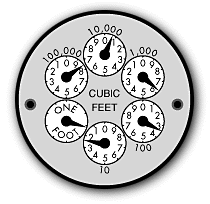

| There are several reasons why you'd want to be able to locate and read
your water meter. First, you might be interested in just how much water
you use in a day. By reading your meter at the beginning and the end of
the day you can compare the two totals tell how much water you and your
family used. The second reason is to check for leaks: you turn off all
the taps in your house, look at your meter and it is still turning, chances
are you have a leak somewhere. Here are some hints to help you find and
read your water meter:
STEP 1: Locate Your Meter
STEP 2: Read Your Water Meter
Many older cities use meters measuring water in cubic feet (one cubic foot equals about 7.48 gallons). Charges for the amount of water consumed are based on the number of units of 100 cubic feet (748.5 gallons) you use during a billing period. There are two basic types of water meters -- the straight-reading meter which resembles the an odometer in a car, and the older model round-reading meter which has several separate dials. How to Read a Straight-Reading Meter
So, if by the time the we read your bills the next time you had used 1,200 cubic feet of water, the new reading would be 82,910 (81,710 plus 1,200). Again, we'd drop the last two numbers and your official reading would be 829. Your bill would be figured by subtracting the old number (817) from the new number (829). You would then be billed for 12 units. It's important to note that the large sweep hand is used only for testing purposes. How to Read a Round-Reading Meter
To read this meter, begin with the 100,000 dial and read each dial around the meter to the 10 dial (the one foot dial is used merely to show that the meter is functioning). If the hand is between numbers, use the lower number. Therefore, the dials at right register 80,632. As with the other meter, the last two figures are discounted, so the number of units registering is 806. If, the next time the meter is read, the meters show the total amount used is 81,847, the total, after discounting the last two numbers, would be 818. By subtracting 806 from 818, we'd find that the bill would reflect a usage of 12 units. |
We can ship your order the same day we receive it via UPS. We accept visa/mastercard/discover and PAYPAL to jonjerman@aol.com. You can fax, e-mail or phone in your order.
www.water-meters.com, www.watermeters.com & www.neptunemeter.com
Jerman Co., 275 Railroad Place, Hackensack, NJ 07601* Phone 800-654-FREE (3733) *Fax 201-487-3953
watermeters.com offers the largest selection of water meters on the internet. We carry every major brand, including our own DLJ line of high quality, low cost water meters. We feature same day shipping, the lowest prices and quantity discounts, expert advice so you get the right meter the first time and credit cards accepted. We were the first on the internet offering water meters, we are still the best. Water Meters are our products, our ONLY products, not a sideline like many internet vendors offering everything from brooms to backhoes.
 In
the meter at the right, the reading is taken from the figures shown under
the words CUBIC FEET. The meter reads 81,710, which is the total number
of cubic feet of water recorded since the meter was installed. Because
our charge is based on units of 100 cubic feet, the meter reader discards
the last two numbers (the ones with the black background). So, this reading
would actually be 817.
In
the meter at the right, the reading is taken from the figures shown under
the words CUBIC FEET. The meter reads 81,710, which is the total number
of cubic feet of water recorded since the meter was installed. Because
our charge is based on units of 100 cubic feet, the meter reader discards
the last two numbers (the ones with the black background). So, this reading
would actually be 817.
 The
meter at the right has several small dials and is a little more difficult
to read than the straight-reading meter. The dials are marked off in divisions
of 10, and are read much like a clock, except that the hand on every other
dial turns counterclockwise.
The
meter at the right has several small dials and is a little more difficult
to read than the straight-reading meter. The dials are marked off in divisions
of 10, and are read much like a clock, except that the hand on every other
dial turns counterclockwise.